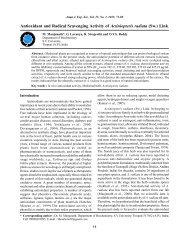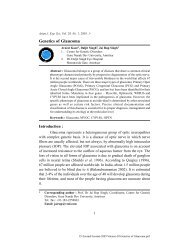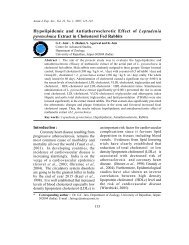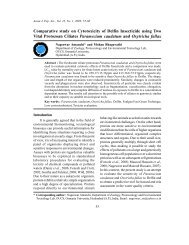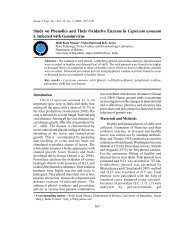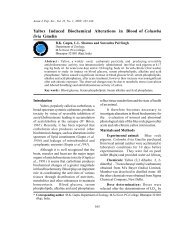Control of Aspergillus parasiticum NCIM 898 infection in ... - Ajes.in
Control of Aspergillus parasiticum NCIM 898 infection in ... - Ajes.in
Control of Aspergillus parasiticum NCIM 898 infection in ... - Ajes.in
Create successful ePaper yourself
Turn your PDF publications into a flip-book with our unique Google optimized e-Paper software.
petroleum products were assessed.<br />
The isolates were obta<strong>in</strong>ed primarily on<br />
Christova M<strong>in</strong>eral medium conta<strong>in</strong><strong>in</strong>g 2% paraff<strong>in</strong> oil<br />
after <strong>in</strong>cubation for 48 hours and selected as<br />
biosurfactant producers based on the rational that<br />
paraff<strong>in</strong> utilization <strong>in</strong>volves the production <strong>of</strong><br />
biosurfactant. (Desai and Banat,1997). Assessment <strong>of</strong><br />
biosurfactant produc<strong>in</strong>g isolate was also carried out<br />
us<strong>in</strong>g<br />
A. Quantitative Haemolysis assay: (Dehghan-Noudeh<br />
et al., 2005) In 5% human RBC suspension prepared <strong>in</strong><br />
McIlva<strong>in</strong>e's buffer (0.2 ml) was <strong>in</strong>cubated for 30 m<strong>in</strong> at<br />
37°C with an equal volume <strong>of</strong> metabolic filtrate<br />
obta<strong>in</strong>ed by grow<strong>in</strong>g S. maltophila <strong>in</strong> Christova's<br />
m<strong>in</strong>eral medium supplemented with 2% paraff<strong>in</strong> oil for<br />
o<br />
96 hours, at 25 C. After <strong>in</strong>cubation, the mixtures were<br />
spun <strong>in</strong> a micro centrifuge (Eltech) at 3000 rpm for 30s.<br />
0.2 ml <strong>of</strong> the result<strong>in</strong>g supernatant was then added to 3<br />
ml Drabk<strong>in</strong>'s reagent (LOBA chemicals) to assess the<br />
amount <strong>of</strong> haemoglob<strong>in</strong> released. Appropriate positive<br />
and negative controls were set up. The absorbance <strong>of</strong> the<br />
samples was determ<strong>in</strong>ed calorimetrically at 540 nm and<br />
% heamolysis calculated as:-<br />
Percentage haemolysis = OD --- OD × 100<br />
(test) (0% control)<br />
OD(100% control )<br />
b. Surface tension reduction activity (Desai and<br />
Banat, 1997, S<strong>in</strong>gh and Desai, 1989)<br />
Surface activity was measured us<strong>in</strong>g CDS-<br />
DuNouy r<strong>in</strong>g tensiometer. 24 hr old S. maltophila<br />
suspension at OD <strong>of</strong> 0.5 was used to <strong>in</strong>oculate<br />
540nm<br />
Christova m<strong>in</strong>eral broth. The flask was <strong>in</strong>cubated under<br />
shake conditions for 92 h and the metabolic filtrate<br />
harvested by centrifugation. Surface tension was<br />
measured by plac<strong>in</strong>g the plat<strong>in</strong>um-iridium r<strong>in</strong>g just<br />
below the surface <strong>of</strong> metabolic filtrate solution, which<br />
then rose through the surface <strong>of</strong> the aqueous solution<br />
until the r<strong>in</strong>g broke. The amount <strong>of</strong> force required for<br />
break<strong>in</strong>g through the surface layer was recorded <strong>in</strong><br />
3<br />
dynes/cm , us<strong>in</strong>g Kruss K 10 tensiometer.<br />
c. Emulsification <strong>in</strong>dex (EI): (Morikawa et al., 1993)<br />
4 ml <strong>of</strong> 72 h metabolic filtrate obta<strong>in</strong>ed after<br />
growth <strong>of</strong> S. maltophila on Christova m<strong>in</strong>eral medium<br />
conta<strong>in</strong><strong>in</strong>g 2% paraff<strong>in</strong> as a carbon source was overlaid<br />
& mixed with 4 ml <strong>of</strong> oil substrates (paraff<strong>in</strong> oil) <strong>in</strong> a<br />
dilution glass test tube (16 by 150 mm).The height <strong>of</strong> the<br />
oil layer <strong>in</strong> the tube was measured <strong>in</strong> cm. The tubes were<br />
then vortex for 3 m<strong>in</strong> and then shaken manually for 2<br />
m<strong>in</strong> to create an emulsion. The height <strong>of</strong> the emulsion<br />
layer was measured after 2 h & 24 hr and emulsification<br />
<strong>in</strong>dex (EI) calculated us<strong>in</strong>g the follow<strong>in</strong>g formula:-<br />
Asian J. Exp. Sci., Vol. 26, No. 1, 2012; 27-38<br />
28<br />
EI (%) = (height <strong>of</strong> emulsion layer)/ (height <strong>of</strong> the oil<br />
plus emulsion layer) X 100.<br />
2 Biosurfactant Production, Extraction and<br />
Purification : (Rahman and Gakpe, 2008)<br />
Potent bacterial isolates S. maltophila was<br />
2<br />
adjusted to a f<strong>in</strong>al density <strong>of</strong> 1X 10 cfu/ml <strong>in</strong> 50 ml <strong>of</strong><br />
Christova's M<strong>in</strong>eral medium with 2% paraff<strong>in</strong>. The<br />
o<br />
flask was <strong>in</strong>cubated at 30 C for 96 h under shaker<br />
condition <strong>of</strong> 100 rpm.<br />
Metabolic filtrate harvested after centrifugation<br />
was adjusted to pH 2 us<strong>in</strong>g 6 N HCl. After an overnight<br />
0<br />
<strong>in</strong>cubation at 4 C equal volumes <strong>of</strong> chilled mixture <strong>of</strong><br />
chlor<strong>of</strong>orm and methanol (2:1) was added to obta<strong>in</strong> the<br />
biosurfactant conta<strong>in</strong><strong>in</strong>g organic layer, which was dried<br />
0<br />
at 40 C for 3 hours. The extraction process was repeated<br />
thrice and the dried mass obta<strong>in</strong>ed weighed and its<br />
prote<strong>in</strong> content was determ<strong>in</strong>ed by Lowry et al. (1951)<br />
method. The extracted biosurfactant was then subjected<br />
to adsorption chromatography (Sa<strong>in</strong>i et al., 2005) us<strong>in</strong>g<br />
silica gel solid-phase column (mesh size 200-300 mesh,<br />
1cm diameter, 6 cm length) saturated with solvents <strong>of</strong><br />
gradually <strong>in</strong>creas<strong>in</strong>g polarity <strong>in</strong> the order <strong>of</strong> chlor<strong>of</strong>orm,<br />
acetone, chlor<strong>of</strong>orm: methyl alcohol (2:1), and methyl<br />
alcohol: Water (2:1). The surfactant harvested was<br />
eluted by sterile glass distilled water overnight to<br />
remove the rema<strong>in</strong><strong>in</strong>g cations, while smaller fractions <strong>of</strong><br />
prote<strong>in</strong>s were removed by add<strong>in</strong>g chilled iso-butanol<br />
(10%) and by centrifugation at 4000 rpm for 10 m<strong>in</strong>.<br />
o<br />
Supernatant was then stored after lyophilization at 4 C<br />
and used as stock surfactant.<br />
3. Sporolytic activity<br />
Zoospores <strong>of</strong> <strong>Aspergillus</strong> parasiticus <strong>NCIM</strong> <strong>898</strong><br />
were harvested us<strong>in</strong>g the method described by Zhou and<br />
Paulitz (1993), where <strong>in</strong> the fungi grown for 72 hours on<br />
Sabourauds agar supplemented with 1% CaCO was<br />
3<br />
flooded with 20 ml <strong>of</strong> sterile distilled water<br />
supplemented with 0.1% Tween 80. After 2 h the<br />
zoospore were harvested by centrifugation and stored <strong>in</strong><br />
o<br />
sal<strong>in</strong>e at 4 C.<br />
1 ml <strong>of</strong> purified biosurfactant <strong>of</strong> S.maltophilia<br />
prepared <strong>in</strong> concentration <strong>of</strong> 2%, 4%, 6%, 8%, and 10%<br />
was mixed with 1 ml <strong>of</strong> <strong>Aspergillus</strong> parasiticus <strong>NCIM</strong><br />
<strong>898</strong> spore suspensions adjusted to m<strong>in</strong>imum <strong>in</strong>fectivity<br />
3<br />
<strong>in</strong>dex <strong>of</strong> 1 X10 spores/ ml (Kasprzyk, 2002) and<br />
<strong>in</strong>cubated for time <strong>in</strong>tervals <strong>of</strong> 10, 40, 60, 80, 100 & 120<br />
m<strong>in</strong>s respectively. The spore biosurfactant mixture was<br />
then observed for the <strong>in</strong>tegrity / burst<strong>in</strong>g <strong>of</strong> the spore<br />
under phase contrast microscope (Olympus CX 31<br />
Asbestos Phase Contrast Microscope). Viability <strong>of</strong><br />
spores was further confirmed by plat<strong>in</strong>g the spore<br />
biosurfactant mixture on Sabouraud's Agar. Percentage<br />
decl<strong>in</strong>e <strong>in</strong> spore viability due to the treatment <strong>of</strong>



